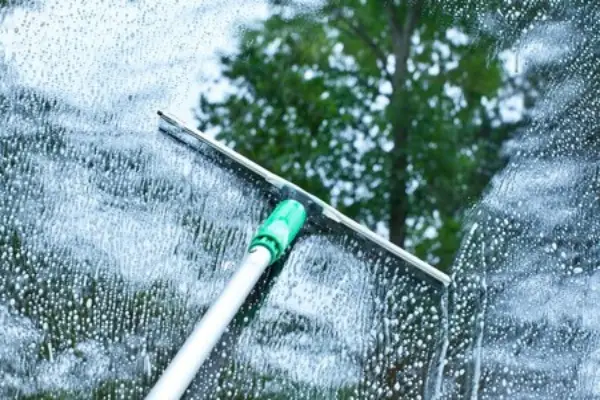
Clean windows not only improve the appearance of your home or business but also provide several functional benefits, such as allowing more natural light in and a clear view of the outdoors.
However, cleaning outdoor windows can be challenging, especially if you have hard-to-reach windows on higher floors or in tricky locations. Prioritizing safety when cleaning outdoor windows is essential to avoiding accidents and injuries.
Here, we’ll provide tips and techniques for cleaning outdoor windows safely and effectively, so you can enjoy sparkling clean windows without putting yourself or anyone else at risk.
What to Know Before Cleaning Outside Windows
Before you start, check the weather conditions and choose a calm, cloudy day to avoid accidents. Next, gather all the essential cleaning materials, including:
- A bucket
- A squeegee
- A scrubber
- Cleaning solution
Lastly, ensure you have the right equipment, such as a sturdy ladder or extension pole, to reach all the windows safely and effectively.
How to Clean Windows You Can’t Reach
Cleaning hard-to-reach windows can be a daunting task, but with the right equipment and techniques, it can be done safely and efficiently.
The first step is to assess the window’s height and determine whether you’ll need a ladder or an extension pole to reach it. Always ensure the ladder is stable and secure before climbing up, and avoid overreaching or standing on the top rungs. If you use an extension pole, fully extend and secure it before starting.
How To Wash Outside Windows in 5 Steps
Washing outside windows can be done with or without a ladder, depending on the height and accessibility of the windows. Follow these five steps to learn how to effectively and safely clean your outside windows, with or without a ladder.
1. Spray Down Windows with a Hose
The first step to cleaning your outside windows is to spray them down with a hose that has an adjustable nozzle. With the hose, spray the windows and any surrounding areas to remove dirt and debris from the surface. Spraying down your outdoor windows with an adjustable hose allows you to turn up the pressure and get the dirt and grime out of difficult-to-reach areas in and around them.
2. Soak a Sponge or Brush in Soapy Water
Before you begin cleaning your outdoor windows, soak a sponge or brush in hot soapy water. First, fill a bucket with hot water. The water should be hot enough to dissolve the soap but not so hot that it will burn or damage your skin.
Next, add your preferred cleaning solution to the water. Dish soap is a cost-effective choice for outdoor window cleaning because it’s gentle on glass and can effectively cut through dirt and grime. If you prefer a natural solution, use a mixture of equal parts white vinegar and water.
After adding your cleaning solution to the water, stir the mixture well enough to evenly distribute it. Next, dip your sponge or brush into the soapy water and let it soak for a few seconds to absorb the solution.
Finally, remove the sponge from the water after fully saturating it with the soap solution and squeeze out any excess water. The sponge should be damp but not dripping wet.
3. Scrub Windows
After soaking your sponge or brush in hot soapy water, you can start scrubbing your windows. If you don’t have a ladder available, using an extension pole can help you reach high windows.
Begin by attaching your sponge or brush to the end of the extension pole. Next, scrub the window from the top and work your way downward. Washing windows from top to bottom helps prevent dirty water from dripping onto freshly-cleaned areas.
Focus on spots with stubborn dirt and grime and use a circular motion to scrub the glass. Continuously rinse your brush or sponge in soapy water to keep it clean and effective throughout the window-cleaning process.
4. Rinse Windows
Once you’ve finished scrubbing your outdoor windows, it’s important to rinse them thoroughly. Rinsing them with your hose will remove all traces of soap and dirt, ensuring that your windows are free of streaks or residue.
To rinse your windows, spray them down with a gentle stream of water from your hose. Ensure that you cover all areas of the window, including the corners and edges, to remove all traces of dirt and soap.
After rinsing your windows, take a step back and confirm that no areas require further cleaning. If you notice any streaks or spots, you can use your brush or sponge to spot-clean these areas. Make sure to rinse the window again after spot-cleaning to remove any remaining soap or dirt.
5. Dry Windows
Now that you’ve finished rinsing your windows, it’s time to dry them. The best way to dry your windows is to use a squeegee; however, a newspaper can be just as effective if you don’t have one handy.
If you have a squeegee, you can use it to remove water left on the glass. Start at the top of the window and pull the squeegee down straightly, wiping the blade clean after each pass. Using firm but gentle pressure, continue working down the window to remove excess water and create a streak-free finish.
You can also use newspaper to dry your windows instead. To do so, crumple up a piece of newspaper and use it to wipe the glass in a circular motion. Wiping the window in a circular motion will help absorb any remaining water and create a clear finish.
Remember These Tips
Cleaning outdoor windows can be challenging, but following these tips can make the process more efficient and safer:
- Clean windows on a cloudy day: Direct sunlight can cause soap and other cleaning solutions to dry too quickly, leaving streaks or spots on the glass. By cleaning your windows on a cloudy day, you can work at a steady pace and ensure you have enough time to rinse and dry your windows thoroughly.
- Use a two-bucket system: Using a two-bucket system can help you avoid spreading dirt and grime. Fill one bucket with clean, soapy water and the other with clean water for rinsing. Dip your brush or sponge in the soapy water, scrub the window, then rinse it in the clean water before dipping it back into the soapy water.
- Clean windows from top to bottom: Starting at the top of your windows and working your way down can help you avoid drips and streaks. It also ensures that you don’t miss any spots because it catches any drips as you clean the lower parts of the window.
- Clean windows frequently to avoid buildup: Cleaning your outdoor windows often can help you avoid a buildup of dirt and grime. Depending on your location, you may want to clean your windows once every few months or more frequently.
Frequently Asked Questions About Cleaning Outside Windows
What should you not use for cleaning windows?
When cleaning your outdoor windows, avoid using paper towels and fabrics that are not microfiber. Paper towels can leave debris from disintegrating paper, while everyday towels often leave behind lint. Use microfiber cloths or newspaper to scrub your windows for the best results.
How often should you wash outside windows?
For most homeowners and business owners, washing your exterior windows 2-3 times yearly is enough. Scrubbing your outdoor windows a couple of times each year will help prevent dirt and other debris from building up and causing other problems, such as liability issues.
To remove smudges and fingerprints in between cleanings, consider using a professional-grade glass cleaner to do the job.
What is the best way to clean outside windows without streaking?
The best way to clean outside windows without streaking is to use a two-bucket cleaning system, a squeegee, and a microfiber cloth. Start by scrubbing the window with a brush or sponge soaked in soapy water from top to bottom.
Next, use the squeegee to remove excess water from the window, starting at the top and working your way down. Finally, use a microfiber cloth to wipe any remaining water from the edges of the window and achieve a streak-free finish.
What do professional window cleaners use to clean windows?
Professional window cleaning services use various tools and cleaning solutions to achieve a spotless, streak-free finish. Some tools include squeegees, scrapers, brushes, and extension poles.
Professional cleaners also use specialized cleaning solutions, such as vinegar and water mixtures, to remove dirt and grime from the windows.
Is Dawn dish soap good for washing outside windows?
Dawn dish soaps are great for cleaning exterior windows because of their cleaning properties. Using dish soap on outside windows can help remove any caked-on dirt and grime.
Need Help Cleaning Outside Windows?
Scrubbing outdoor windows can be challenging and time-consuming, especially if you have a multi-story home or commercial building. If you’re feeling overwhelmed or don’t have the time or equipment to clean your windows on your own, consider contacting a professional window cleaning service like Window Genie.
At Window Genie, we specialize in providing high-quality, professional window cleaning services for homes and businesses of all sizes. Our experienced technicians use state-of-the-art equipment and cleaning solutions to leave your windows sparkling clean and streak-free.
In addition to traditional window cleaning services, we offer pressure washing services to help keep your property looking its best. From cleaning your siding to washing your driveway and sidewalks, we can help you tackle even the most challenging outdoor cleaning tasks.
So, if you’re ready to take the hassle out of cleaning your outdoor windows, contact us today to learn more about our services and get a free quote.
